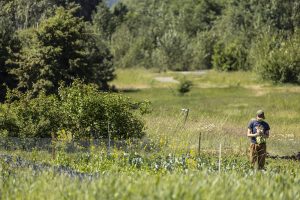
The soil beneath our feet may not often catch our attention, but keeping it healthy can have major impacts on climate change and the overall sustainability of our food production system. A new study of agricultural practices at the UW Farm, led by recent ESS graduate Julia Macray and Professor David Montgomery, demonstrated that even relatively small changes to the ways we farm can help restore soil health and sequester carbon from the atmosphere.
“The UW Farm is doing really incredible work, and some very simple agricultural practices have done a lot to improve its soil health,” said Macray, who completed the work as an undergraduate in the Department of Earth and Space Sciences. “It’s an example of the potential for climate remediation and carbon sequestration on a small scale in an urban environment.”
Farming for topsoil
The study focused on the health of topsoil at the UW Farm, a 1.5-acre student-powered urban farm and educational facility located on what used to be a massive dumping site and landfill. The researchers measured changes to the topsoil’s thickness as well as the overall amount of organic matter and carbon that it contained over the 20-year period since the farm began operations. Thicker topsoil with more organic matter is generally healthier and promotes better crop growth, while sequestering carbon in the soil keeps it out of the atmosphere and can help slow the process of climate change. Healthy soil is also less prone to erosion, and can help control flooding.

Macray found that, under the UW Farm’s regenerative practices, topsoil thickness increased four-fold over the 20-year study period — growing at a rate of just under 1 centimeter per year. Soil organic matter increased as well, but was more variable year to year.
“What Julia’s research showed is that at the UW Farm, they turned a garbage dump into really productive soils in about 20 years,” Montgomery said. “That’s screamingly fast, especially from a geological perspective.”